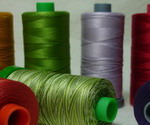Most of the projects I make involve fairly intense hand work, such as needleturn applique and English paper piecing. Here’s one of my current projects.
Even under “optimal conditions” (no housework, no paid employment, neglected hubby and family, and little sleep) such projects progress slowly. Much as I love this activity, it’s sometimes nice to have a change of pace and produce something that goes together more quickly and with less effort.
I have recently made such a quilt.
While distracted (i.e. browsing on the internet) I saw a quilt which I thought had an interesting layout. There was no name or pattern, but that did not deter me as I simply drafted my own, using dimensions of my choice. I had some suitable fabrics in my stash so I was able to begin without delay.
The blocks are simple and require only two seams.
The trickiest thing is to ensure the correct orientation of all the blocks once they are pieced. Check and check and check before joining!
I used the red sashing fabric to add a border around the edge to frame the quilt and bound it in the same fabric to maintain the framed look. In the photo below, I am trialling the position of the blocks and the border.
With my long-arm machine, quilting my projects is straightforward. My quilting business, “The Quilt House” is located in Vermont South, Victoria. Check out my website : http://www.thequilthouse.com.au
I decided to use an all over quilting design (edge-to-edge) 0n the quilt, in this case I chose Lorien’s “Twirly Feathers”. It’s a really elegant design.
For this type of quilting, I use Aurifil 40 weight thread on my Gammill quilting machine. I chose a red thread to match the sashing fabric. It provides a nice contrast with the gold coloured backing fabric.
And here is the quilt used as a topper on my bed. I called it “Just Because”………well, just because!
Filed under: Aurifil, Cotton Mako' Ne 40, Home page, Quilting | Tagged: applique, Aurifil, Cotton Mako 40, Cotton Mako', design inspiration, machine quilting, Quilting | 4 Comments »































 Naturally I used Ne 50, Ne 40, Ne 28 and Ne 12 in the art journal construction!
Naturally I used Ne 50, Ne 40, Ne 28 and Ne 12 in the art journal construction!

























































